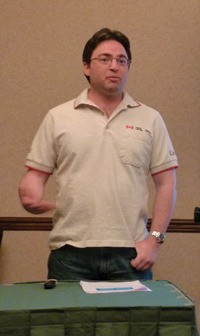The Friends of Kootenay National Park were proud to present archaeologist Brad Himour, a guest speaker for the Wild Voices Speaker Series. The presentation was held at the Prestige Inn in the Village of Radium Hot Springs on April 9, following the Friends of Kootenay’s annual general meeting.
Himour, who graduated from the University of Saskatchewan, has spent 10 years in archeology consultation, and has studied underwater archeology at the University of West Florida and in Peru.
Himour’s latest and continuing project is that of the pictograph sites scattered around the British Columbia-Alberta border, and further into the Kootenays.
The pictographs are images painted with red ochre that had faded over time, left by Aboriginal groups 100 or more years ago.
“We’re concerned about managing these sites, but they were made by Aboriginal groups who were here long before provincial boundaries, so we decided to look at these as the groups would,” said Himour.
The heart of the project was preservation, which came in two flavours: cultural and physical.
Himour and his team has taken elders from First Nations groups to the sites, or brought them photos of the pictographs to have their meaning interpreted.
The Ktunaxa, the Piikani, the Stoney Nakoda and the Kinbasket were consulted about the pictographs.
Physically preserving the pictograph sites was far more challenging, however, as the the sites “were never intended to last,” according to Himour.
The sites were intended to fade over time due to natural weathering. To respect this, Himour and his team preserved the pictographs at the sites by taking high-resolution pictures with a digital camera in specific light settings.
“We found this to be the less-intrusive way,” Himour said.
Due to the fading of the captured pictographs, Himour and his team used NASA-developed technology Dstretch to bring the painted ochre forward, creating striking images that kept the details and the pictograph in plain site.
There would be times Himour and his team would visit a supposed site, only to not see any pictographs due to natural fading. Taking pictures and running them through Dstretch showed pictographs almost lost by time, but now preserved through photography.
“They were meant to fade, so we left them that way,” said Himour. “Now that we have them on photographic record, we have a way to preserve them, and we can leave sites as they are.”
